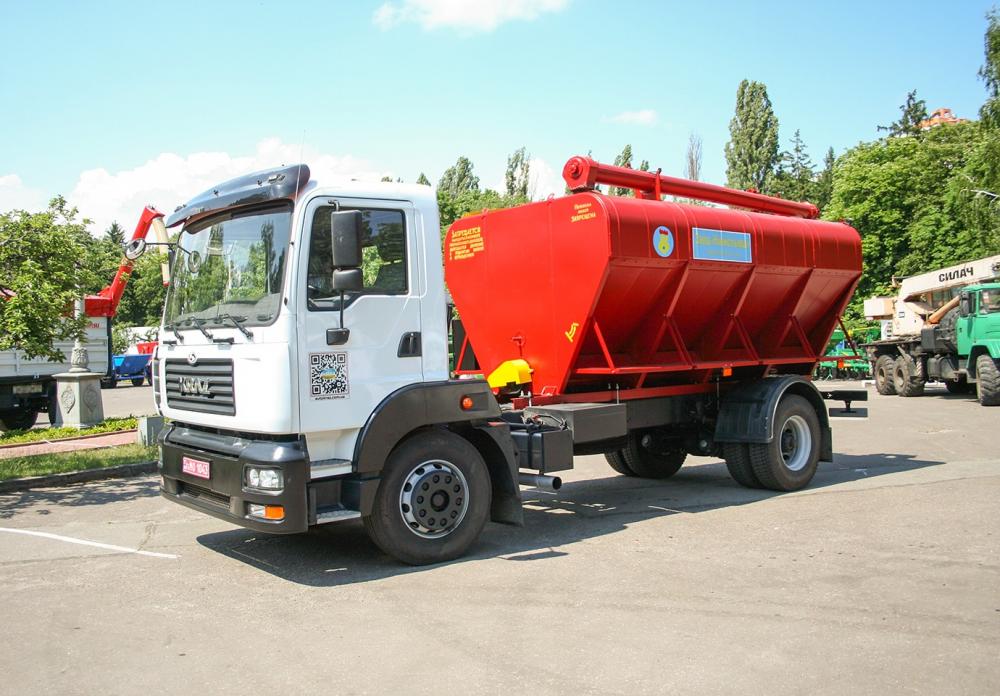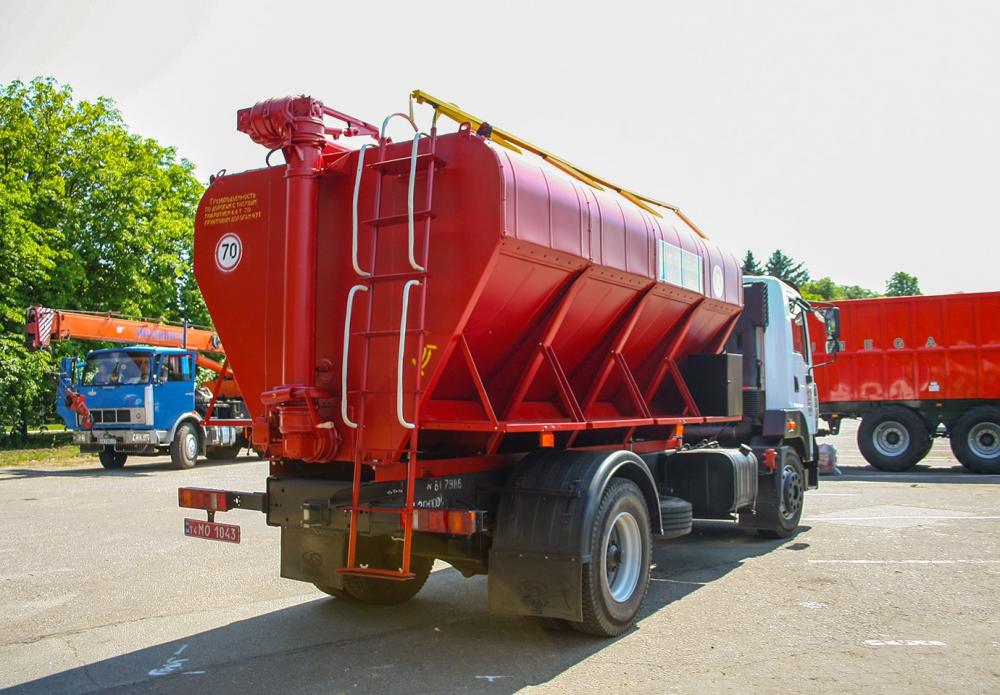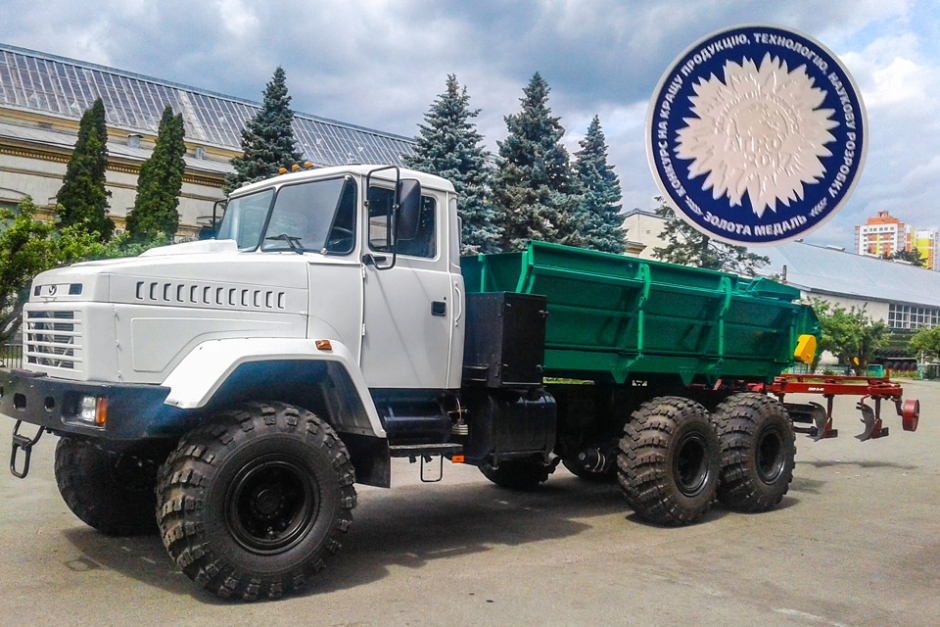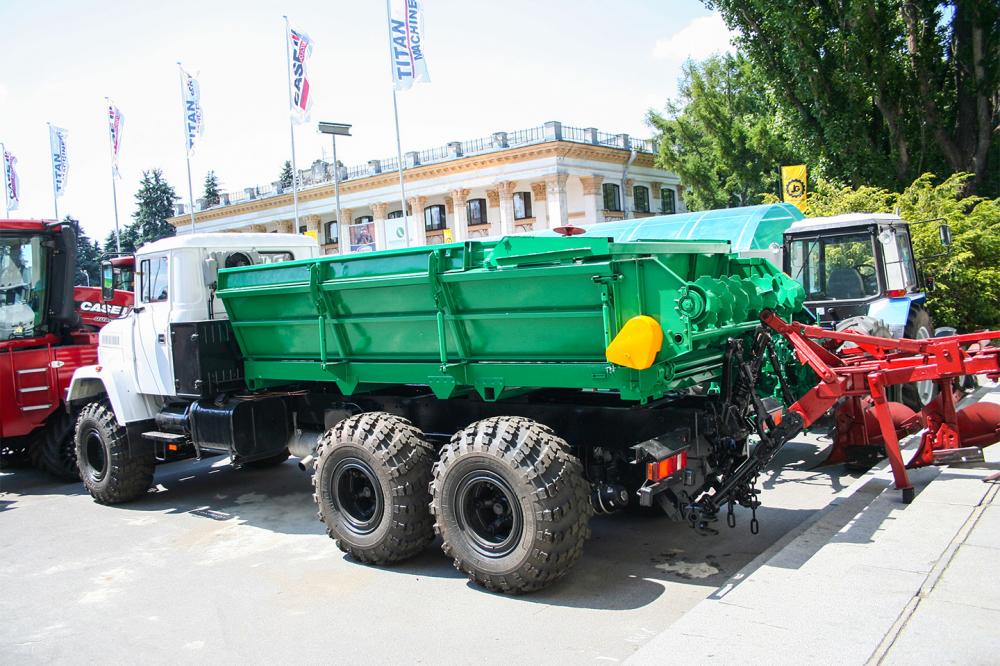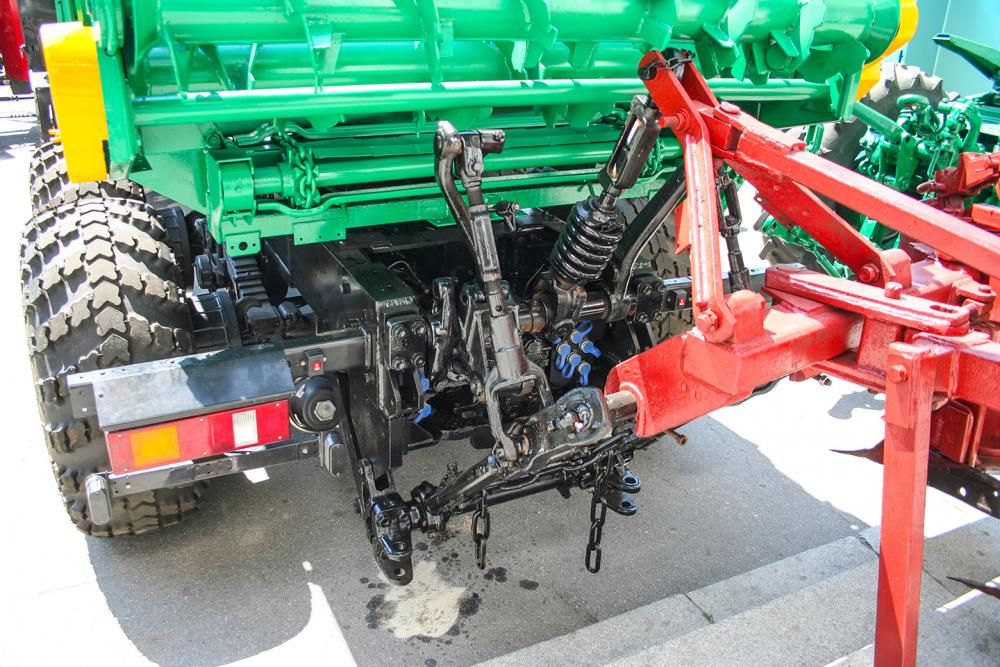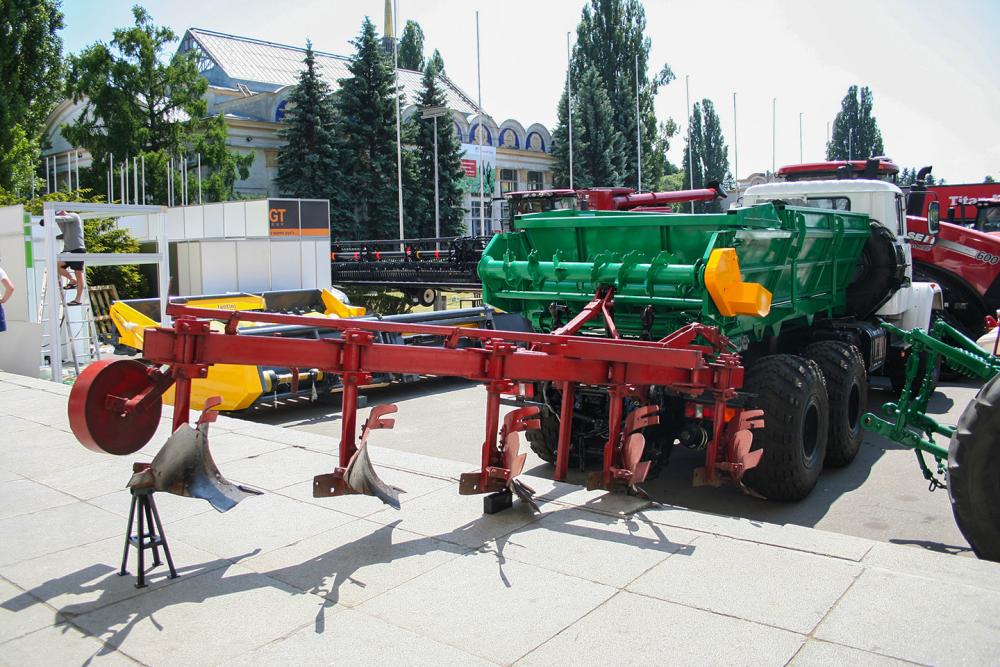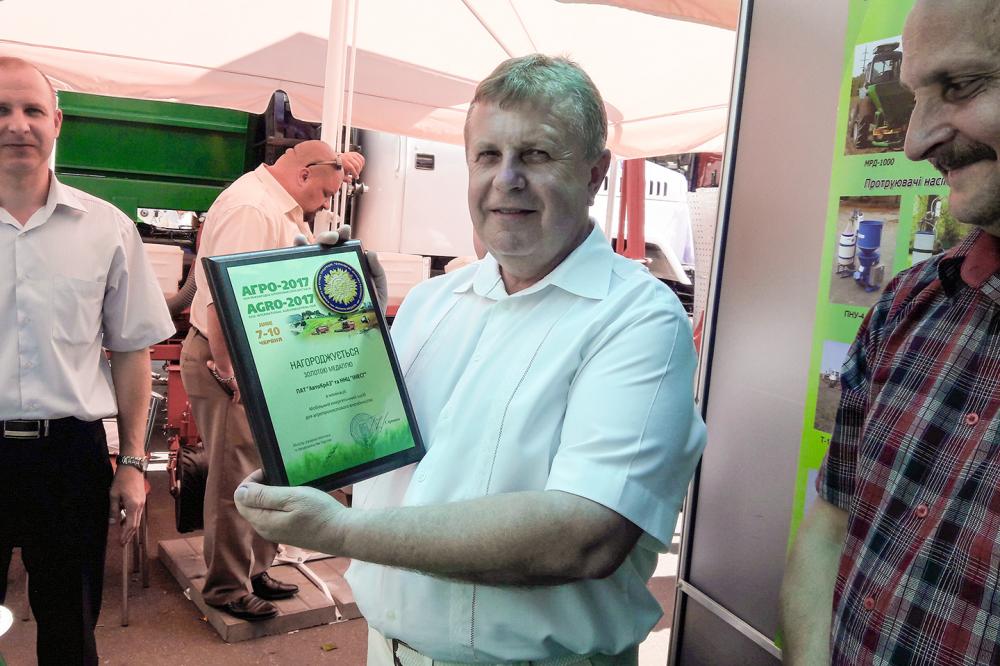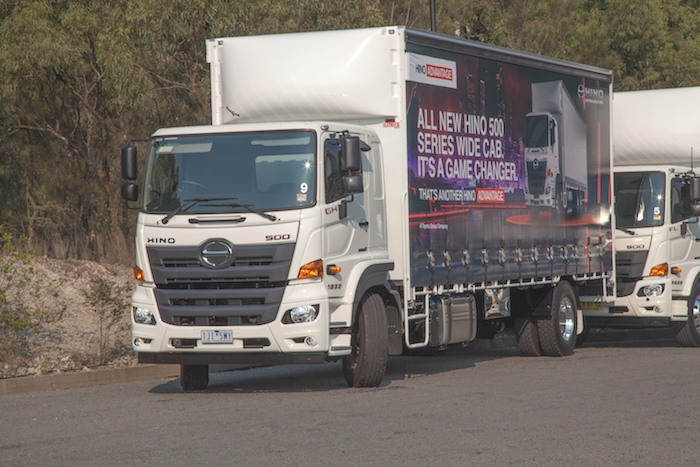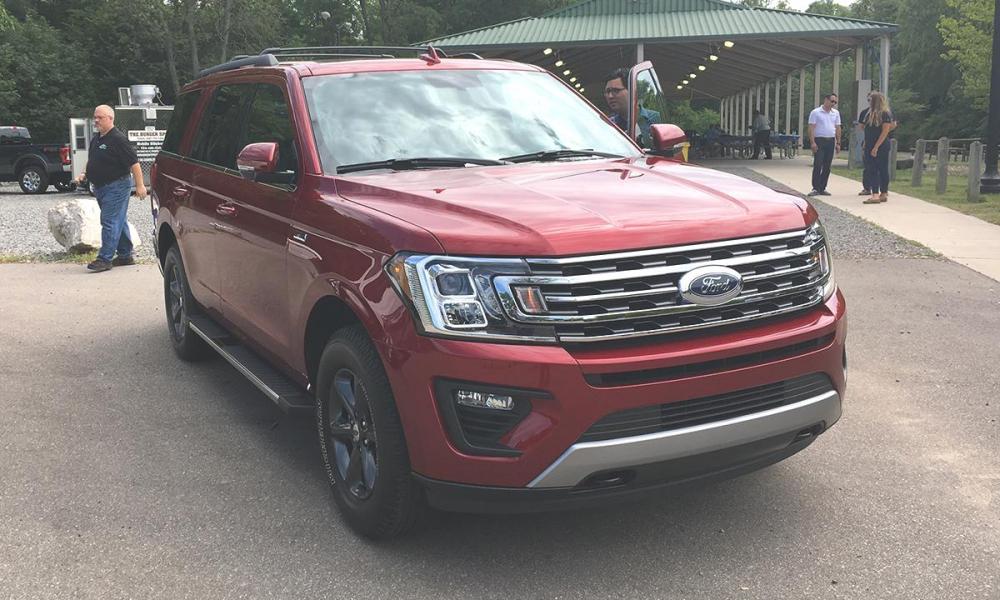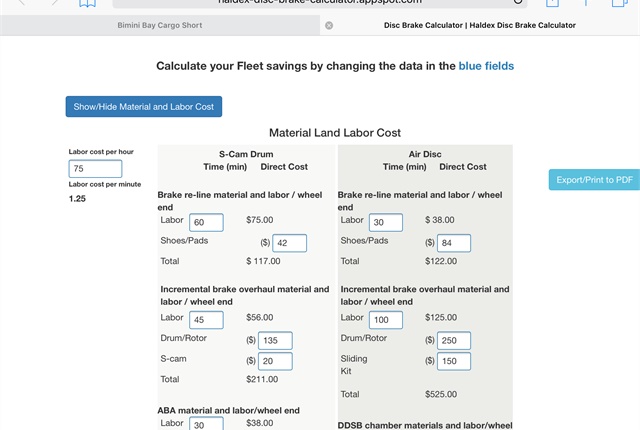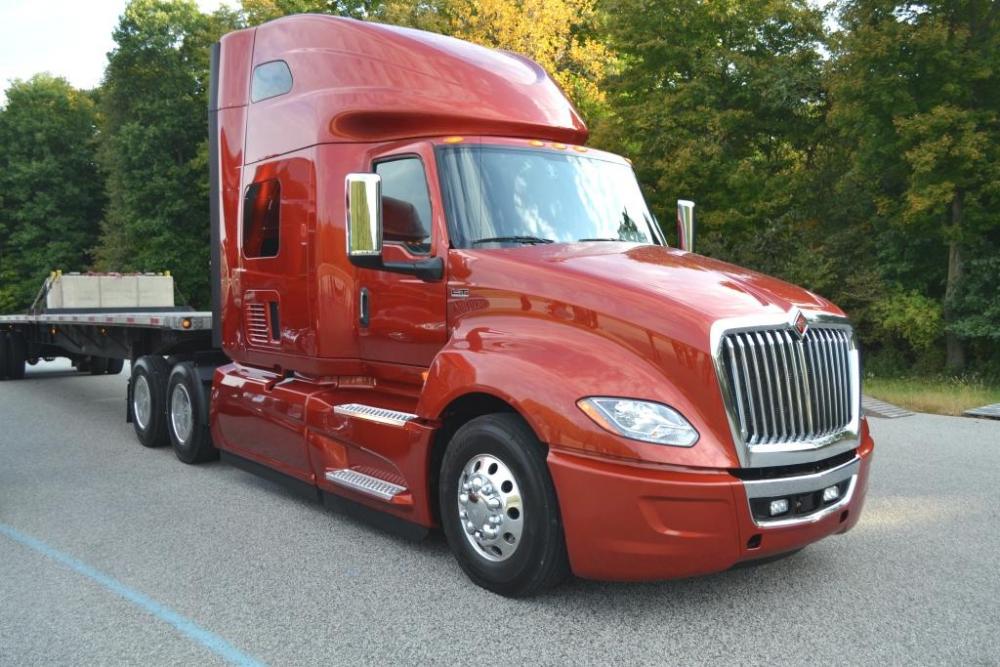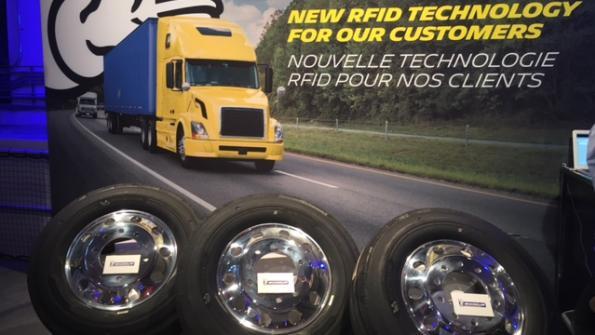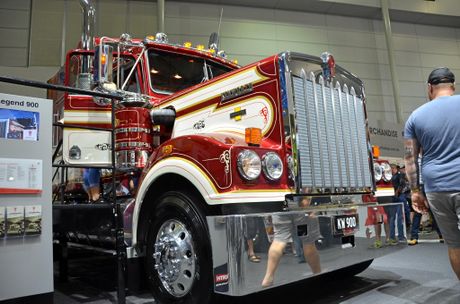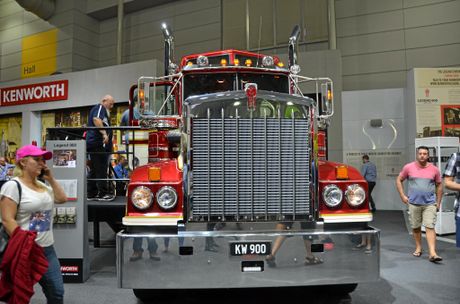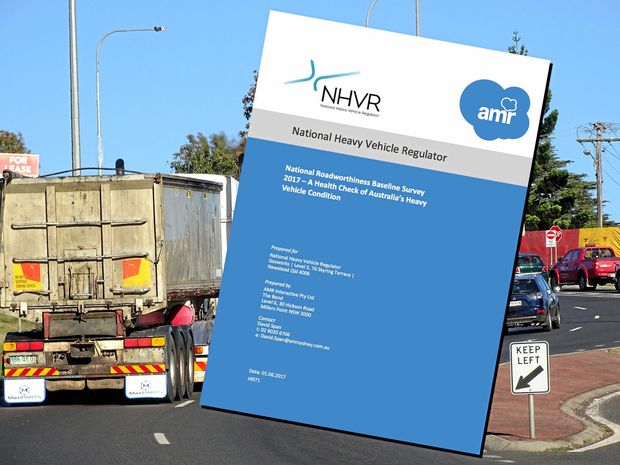
kscarbel2
Moderator-
Posts
17,893 -
Joined
-
Days Won
86
Content Type
Profiles
Forums
Gallery
Events
Blogs
BMT Wiki
Collections
Store
Everything posted by kscarbel2
-
“We have wasted an enormous amount of blood and treasure in Afghanistan. Their government has zero appreciation. Let's get out!” Donald Trump / November 21, 2013 --------------------------------------------------------------------------------------------------------------- Associated Press / June 16, 2017 WASHINGTON — The Pentagon will send almost 4,000 additional American forces to Afghanistan, a Trump administration official said Thursday. The decision by Defense Secretary Jim Mattis could be announced as early as next week, the official said.
-
KrAZ Trucks Press Release / June 13, 2017 The ZSK-F-15 dry forage loader based on the KrAZ-5401Н2 4х2 chassis is another exciting new product introduced by KrAZ at Agro-2017. The KrAZ-5401 vehicle provided with the ZSK-F-15 special equipment is the first pilot project in partnership with Ukrainian machine-building company “Zavod “Nezhinselmash”. The special vehicle is used for carrying and loading forage in hoppers of poultry and stock farms. It can be used for bulk transportation of grain, combined feed and pelleted forage. The equipment is mounted on the KrAZ-5401 two-axle new generation chassis offering maximum commonality and adaptation to various power plants and superstructures. The engine rated at 312hp meets Euro-5 emission standard, transmission is manual, double-range unit. At customer’s request, other power plant, cab, superstructure are available as option. The is provided with 11 cu.m. 4-section hopper, 8 and 13,75 cu.m. hoppers with 3 or 5 sections respectively are available as options. Novelty for animal breeding has been carefully checked out by numerous attendees of KrAZ stand throughout the exhibition duration. According to them, KrAZ is headed in the right direction; extending its lineup of vehicles for both military and civilian use. It is gratifying to emphasize that manufacture of two-axle agricultural vehicles has been well regarded and supported by farmers and agrarians. They offer to manufacturer to add grain carrier to 4х2 lineup in the light of strict requirements to highway loads, precluding the use of grain carriers with curb weight exceeding 40 tonnes. .
-
KrAZ Trucks Press Release / June 12, 2017 These are results of participation of Ukrainian truckmaker KrAZ at the most important agro-industrial exhibition of Ukraine Agro-2017. KrAZ earned the most significant award for newly designed MEZ-330 (mobile power source) based on the KrAZ-6322 off road chassis for agricultural sector developed jointly with National Research Centre “Institute for Agricultural Engineering and Electrification”. The KrAZ-6322 base chassis is provided with PTO shaft, hydraulic equipment, additional linkage for plough and other agricultural equipment. The MEZ-330 tractor can be used in both transport and agricultural applications such as spreading fertilizers, working the soil, sowing, spraying crops, handling, etc. The first prototype exhibited was provided with body for spreading solid organic fertilizers that can be equipped with ploughs and other attachments. Workshop Future Development of Mobile Power Sources in Ukraine has been conducted as part of the exhibition, where representatives of NRC “IAEE” and KrAZ gave talks about creation of various special vehicles based on KrAZ chassis. According to doctorial candidate of the Institute for Agricultural Engineering and Electrification Mr.Sergey Pogoreliy in charge of MEZ project, newly designed product will enable to replace the KhTZ-17221. Similar solutions are applied in Germany where such tractors are based on MAN and Mercedes-Benz chassis. It was noted that KrAZ tractor is cheaper as compared with foreign-made tractors Fendt-936, Massey Ferguson-7926 and domestic-made KhTZ-17221. Those present listened to report delivered by farm manger Mr.Zadorozhniy from Vinnitsa region who uses 9 KrAZ trucks instead of tractors for plowing, sowing, working the soil, etc. He emphasized that KrAZ vehicles are more fuel efficient and easier in maintenance, offer reduced operating costs and affordable after-sales service. On completion of the workshop attendees checked out the MEZ-330 based on the KrAZ-63221 exhibited at NRC “IAEE” stand. Here KrAZ and NRC “IAEE” have been awarded the highest award, gold medal in category Mobile Power Source for Agro-Industrial Sector. .
-
Built-in Flexibility Diesel News AU / June 2017 The modern truck has a lot of built-in flexibility, and the Hino 500 range is no exception. The models available range from the lighter end of medium-duty up to some serious heavy-duty rigid trucks. This means the trucks are going to experience very different working lives and need to be capable, no matter what the task. Hino has looked at what they have on offer in the 500 Series and made a number of changes to increase the breadth and depth of its offering to the market. This means new chassis, new engines and new combinations of existing components. “Our previous range offered 33 models and we have now expanded that to 51, so when it comes to choice of engine capacity, transmissions, suspensions, and wheel bases, customers have a myriad of options,” says Daniel Petrovski, Hino Manager Product Strategy. “The new FG, GH, FL and FM offer a broader range of applications than ever before. “The all-new 500 Series has taken a long time to get here. The last release of an all-new model range was in 2011. In commercial vehicle terms, the wait is just about right on time. The basic DNA from design and manufacturing on any Hino truck is ‘QDR’ – quality durability and reliability. The new 500 Series project began in 2009, when Hino carried out back-to-back testing and benchmarking against our competitors on Australian roads over a number of weeks. “Some of the changes from that testing were put into place on upgrades in 2010 and 2013, like SRS airbags, Isri driver’s seat and electric heated mirrors. But the work on delivering the results of the 2009 testing didn’t stop there. “Australia is not the first to get these new models, they were released in Thailand and Indonesia in 2015. Australia is the first advanced market to receive this new model. It is a major new model for us – there are new engines, new exhaust emissions, new exterior, new staircase for entry and exit, new manual transmissions, Allisons across the range, new chassis and chassis layouts, diffs, drives steering axles, suspensions and new levels of safety.” At the heavier end of the range, Hino is now using the chassis design and concept it is currently using on the Hino 700 heavy-duty truck. This is a more flexible design with predrilled holes on the web of the chassis members and with a rivet-less flange. The holes are 50mm apart along the length of the chassis, enabling both Hino and body builders to place components like fuel tanks and body mounts anywhere along the chassis. The name of the game in this segment of the market is to ensure the truck buyer can build whatever kind of truck they like from a generic base model, without having to resort to major vehicle modifications. “We call the new chassis, ‘body-builder friendly’,” says Daniel. “It is an 840mm-wide, grid-hole chassis. It features a vaulted frame structure and a clean top flange, eliminating the need for a space between the chassis and a subframe. This is already showing real efficiency for body builders. “They are high tensile 620MPa steel now, the same as the 700 Series. It is electro plated, which helps with rust resistance. The modular chassis pattern means things like batteries, exhausts and air dryers are now all modular components. We have spent a lot of time talking to Australian body builders about where different components need to go in certain applications.” .
-
Reuters / June 15, 2017 Volkswagen is strengthening its presence in Russia with projects to boost its VW and Skoda brands as well as commercial vehicles as the automaker positions itself for a rebound in the Russian market. VW said on Thursday it had extended a deal with Russia's GAZ group to assemble VW brand and Skoda cars until 2025. As part of the agreement, VW will also supply 2.0 litre diesel engines to light commercial vehicles made by GAZ. The prolonged decline of the once-booming Russian car market caused General Motors to leave in 2015 but VW has kept investing and started making engines at a new plant in Kaluga, some 170 km (105 miles) southwest of Moscow two years ago. Volkswagen is the world's biggest carmaker by sales and is the leading foreign automaker in Russia by sales and revenue. In a separate statement, VW said its truck and bus division had signed a letter of intent with GAZ to examine a long-term business cooperation in commercial vehicles. The two companies are considering a strategic partnership for supplies and joint assembly of components, and possible projects will be examined in a next phase, VW said. GAZ already uses components from VW's Scania and MAN heavy-truck divisions for its buses. "With this letter of intent, we are taking another important step in our global champion strategy and are clearly demonstrating our commitment to the Russian market," VW trucks chief Andreas Renschler said. Car deliveries in Russia by the VW group, which includes the luxury Audi and Porsche brands, fell 4.3 percent to 166,900 last year. But there are signs of a rebound as Russian new car sales rose 6.9 percent in April and 15 percent in May.
-
Truckmakers Get Record $3.24 Billion EU Fine for Cartel
kscarbel2 replied to kscarbel2's topic in Trucking News
Truckmakers face £3.9bn UK legal claim over price fixing The Financial Times / June 14, 2017 UK’s Road Haulage Association (RHA) seeks compensation after cartel of five groups found guilty British lorry drivers are to bring legal action demanding £3.9bn in compensation against a Europe-wide cartel of truckmakers that fixed prices for 14 years. In July last year Brussels found five truckmakers — Iveco, DAF, Volvo/Renault, Daimler and MAN — guilty of colluding to raise prices together and fined them €2.93bn. A sixth, Scania, is still being investigated after refusing to co-operate with the European Commission’s probe. On Wednesday the UK’s Road Haulage Association, which represents lorry drivers, will announce plans to bring a case to the UK’s Competition Appeal Tribunal against all six companies to demand compensation. The tribunal is a government-backed agency, led by judges, that rules on competition issues and has the power to levy fines. In the case, the RHA is seeking £6,000 compensation per vehicle, reflecting higher prices charged by the manufacturers while the cartel was operating. With an estimated 650,000 lorries sold between 1997 and 2011 in the UK, the total bill for the truck groups could rise to as high as £3.9bn if every truck owner takes part in the action. Between them the six companies control almost the entire European truck market, and are expected to face additional legal action from the continent’s 600,000 hauliers, most of which are small businesses. Richard Burnett, chief executive of the RHA, said: “UK truck owners affected by the truck cartel have potentially paid too much for their lorries over a 14-year period and we’re determined to get a fair deal for them.” He said members were “angry about the truck pricing cartel and want us to represent them” in the case. The commission began the investigation in 2011 after a tip-off from a whistleblower at MAN, which is owned by Volkswagen. As a result, MAN escapes a fine that would have been €1.2bn, even though it was found guilty of colluding with the other companies. In its findings last summer, the commission said its ruling was “binding proof that the behaviour took place and was illegal” that could be used by “any person or firm affected by anti-competitive behaviour” in a legal claim in their own country. It added: “Even though the commission has fined the companies concerned, damages may be awarded without being reduced on account of the commission fine.” The RHA on Wednesday will say it has secured funding for its case from Therium Capital Management, a company that specialises in funding one side of a lawsuit. Previous cases backed by the group include a class-action type lawsuit by Lloyds Banking Group shareholders. -
Scania Group Press Release / June 15, 2017 Ola Karlsson has been driving trucks professionally for 30 years, in which time he has seen almost everything. Now he delivers flat packs for IKEA and field-tests a Scania R 520 6×2 Euro 6. In 30 years of professional driving, Ola Karlsson has driven most types of vehicles, including semi-trailers, charter buses and forest trucks. He is currently working for Kaj Inrikes, a haulage company based in Älmhult, Sweden. The vast majority of the goods the company transports are flat packs from IKEA. He is driving a R 520 6×2 Euro 6, which he is field testing for Scania. Karlsson’s dream was to drive a forest truck, but it didn’t work out straight away. “When I was 10 years old I had the opportunity to ride a truck in the forest and it felt like something special,” he says. “But when I started driving, it was difficult to get a job as a timber truck driver. There were many family businesses in the industry, and they preferred to employ family members.” DRIVING BEHIND THE IRON CURTAIN Instead, Karlsson did something that many young drivers dream of: He went abroad to drive. Karlsson’s first job involved driving to Greece, Yugoslavia and Turkey. Later, he drove in both Western and Eastern Europe, at a time when the Cold War and the Berlin Wall were still a part of everyday life. “Driving to East Germany, Romania and other countries behind the Iron Curtain was exciting,” he recalls. “The conditions there were so different from what I knew at home. On one occasion we were stopped by the police for a made-up speeding offence. Getting out of the situation cost eight Swedish kronor with a receipt, or four kronor without one. It was a different world, even though it wasn’t so long ago.” During his first years in the job, Karlsson drove a Scania 111. He remembers picking a passenger seat that would enable him to take his canned food on the road. And he remembers how drivers from the West used to gather around in the evenings. “We would light our camping stoves in the lee of the wind behind a trailer, cook dinner and hang out,” he says. “I can’t really say this is the way I would want to do it now, but it was fun. Over the years I have met so many people on the road. That’s one of the great advantages of this job.” MAKING DREAMS COME TRUE After nearly 20 years, Karlsson’s early dream came true. He got a job as a timber truck driver. It was just as good as he thought it would be, but in the end it became too physically demanding. “The work shifts were very demanding,” he says. “For three weeks a month we would start at 3 in the morning and I never had the time to catch up on sleep. It was like living with permanent jet lag. After 12 years, I just couldn’t continue any longer. But from time to time I still miss the forest and driving through it.” Now Karlsson drives every other week and only during the day. He leaves on Friday morning and drives for six days. His load consists exclusively of goods that are transported to the IKEA warehouse south of Gävle. He drives to the unloading site and gets a good night’s sleep in the truck. “It has happened that I woke up with an empty truck,” he says. “But now I always set an alarm clock so that I don’t miss the unloading.” PRAISING THE ENGINE AND THE SAFETY FEATURES This is Karlsson’s first job as a field test driver, and he is impressed by his R 520 6×2 Euro 6. It has been a while since he last drove a Scania, and he likes how the brand has developed. “This is an excellent truck. I like it a lot,” says Karlsson. “I have driven V8 trucks with very thirsty engines, but this one only consumes 37.4 litres per 100 kilometres with an average load, which I think is good, and if I drive trailers with a total weight of 35 tonnes, it consumes less than 30 litres per 100 kilometres. Simply said, it has an awesome engine.” Karlsson makes use of the other advantages that the truck offers. “I use cruise control to drive 30 to 40 kilometres per hour, so I never have to worry about changing gears,” he says. He also likes the advanced emergency braking system. “A while ago, driving through Gothenburg during rush hour, I could feel butterflies in my stomach – people from the city drive like crazy and they don’t even check their mirrors before changing lanes. That means I occasionally got collision warnings, but the truck always takes care of it and reacts quicker than I do. The same thing happens on roads outside the city. The truck starts braking before I even see the roe deer in the ditch by the road.” SMOOTH OPERATION This is the second time over the course of his working life that Karlsson has worked for Kaj Inrikes in Älmhult. And he only has good things to say about the haulage company, which has 25 trucks, 50 permanent “guys” and a dozen extra drivers who all drive for Ikea. “Everything is well organised here, so there’s no hassle,” Karlsson says. “This is something we mostly have the office team to thank for. The company is like a self-playing piano.” Karlsson admits that working far away from home and family is difficult. “When you’ve driven 1,500 kilometres and you find out that something troublesome has happened at home, that can be really stressful,” he says. “My two older children barely saw me when they were growing up. But I’m trying to catch up on that now with my 11-year-old.” It is almost time to use the microwave to warm up a box of Thai food for lunch. While he is eating, Karlsson takes some time to think about the meal he is going to prepare when he gets back to Älmhult. On top of everything else, he is also a trained chef. .
-
Scania Group Press Release / June 15, 2017 Field test driver Rickard Sjöstrand loves the roar of his V8 engine. And Scania loves to know what the experienced driver thinks of the new truck generation. Sjöstrand is driving a Scania S 650 6×2 Euro 6. He’s had it since the summer of 2016 and starting the engine is still a pleasure. “My previous truck was also a Scania V8,” Sjöstrand says. “But this new engine rumbles even better.” THE IMPORTANCE OF ENGINE POWER As a field test driver evaluating the next generation of trucks, Sjöstrand also appreciates the power of the new V8. “My old truck only had 580 hp. This new one has 650 hp, which makes a huge difference. The engine is really powerful and works well. You would think that a bigger engine would consume more fuel, but it actually consumes three litres less per 100 kilometres than the previous one.” Sjöstrand was chosen as a field test driver by his employer, Eurolink, based in Ljungbyhed. “Of course, I hope they asked me because I’m good at my job and not because somebody else had already turned down the offer.” TWO YEARS OF FIELD TESTING Sjöstrand will be driving the S 650 until summer 2018, all the while reporting to Scania about his experience. “This is the second time I’ve worked as a test driver,” he says. “It’s a great experience for me to help with the development of new trucks, and I think that Scania listens to my opinions.” Sjöstrand is on the road every weekday, two weeks on and one week off. He transports bags of concrete from Strängnäs, in the Swedish province of Södermanland, to 20 home improvement centres in Stavanger and Oslo in Norway. He carries three pallets at a time, which take 15 minutes to load. He often drives to the unloading site in the evening and sleeps there, sometimes meeting friends. “When I went there yesterday a colleague of mine had heated up the company’s sauna,” he says. “Being able to sit and talk a bit made for a pleasant evening.” GOOD LIFE IN A TRUCK Over the years, the E18 has become Sjöstrand’s second home. He has audiobooks to keep him company and he trades suggestions for books to listen to with a colleague. “I’ll listen to almost anything,” he says, “but I want to like the main characters in the book. Some personal favourites of mine are The Hundred-Year-Old Man Who Climbed Out the Window and Disappeared, and A Man Called Ove. Both have been turned into really good movies as well.” This fall marks Sjöstrand’s 15th year as a professional driver, but he’s been travelling in the cabin of a truck much longer than that. His father, a freight manager, and other relatives drove trucks, and he says he has many memories of sunny summer roads. “We had relatives in the province of Dalarna, and ever since I was a little kid we would drive a truck there for the holidays. When I grew a little older, I would spend whole holidays in the truck. That feeling of sitting high up in the truck, that’s the good life – that’s freedom for me.” . .
-
Ford F-150, Expedition gain power, lose weight Automotive News / June 15, 2017 DETROIT -- Ford Motor Co. has increased the power and cut the weight of two of its largest nameplates -- the F-150 pickup and Expedition SUV -- thanks, in part, to more efficient transmissions and lighter aluminum bodies. The freshened F-150 will feature a new entry-level 3.3-liter V-6 with a six-speed transmission. It will get 290 hp at 6,500 rpm and 265 pounds-feet of torque at 4,000 rpm, the automaker said. Ford is also updating its 2.7-liter EcoBoost, 3.5-liter EcoBoost and 5.0-liter V-8 engines, and is pairing its 10-speed transmission with all three. Since its release late last year, the 10-speed has been available only with the 3.5-liter. The 2.7-liter EcoBoost will get 325 hp at 5,000 rpm, the same amount of horsepower as the outgoing model. It will get 400 pounds-feet of torque at 2,750 rpm, which is 25 more pounds-feet than the 2017 model. The 5.0-liter V-8 will get 395 hp at 5,750 rpm (10 more than the 2017 model) and 400 pounds-feet of torque at 3,850 rpm (13 more than the 2017 model). There are no changes to the 3.5-liter EcoBoost V-6 or the 3.5-liter high-output EcoBoost, which is used in the Raptor. The 2018 F-150 will also feature a 3.0-liter PowerStroke diesel engine option, although Ford did not provide power figures for it on Thursday. The diesel, a variant of the Lion diesel engine that Ford builds for use in Land Rover and Jaguar vehicles, will be produced in England and go on sale in the summer of 2018. The non-diesel versions of the F-150 will go on sale this fall. Improved Expedition power The redesigned 2018 Expedition, which Ford unveiled this year, will continue to share the 3.5-liter V-6 with the F-150 and will now pair it with Ford's 10-speed transmission. It also adds an aluminum body that shed 300 pounds. The weight savings and more efficient transmission allowed the company to improve its power numbers across the board. The Expedition's XL, XLT and Limited trims get 375 hp at 5,000 rpm (10 more than the 2017 model) and 470 pounds-feet of torque at 3,500 rpm (50 more than the outgoing model). The Platinum trim will get 400 hp (35 more than the outgoing model) and 480 pounds-feet of torque at 3,250 rpm (60 more than the outgoing model). The Expedition will go on sale this fall and will be built at Ford's Kentucky Truck Plant. Off-road package Ford on Thursday also said it will offer an off-road package on the XLT trim on the 2018 Expedition, called the FX4. Ford last offered an FX4 package for its largest SUV in 2003. Brand manager Joe McCarty said roughly 20 percent of Expedition customers have asked for improved off-road capability. "I think we're meeting an unmet need with this package," he said. Craig Patterson, Ford's utility marketing manager, expects the FX4 will represent 5 to 10 percent of total sales. Pricing was not announced. The FX4 package comes with a patented electronic limited-slip rear differential, off-road tuned shocks, all-terrain tires, skid plates, unique wheels, special badging and rubber floor liners. The off-road package will get the same 375 hp and 470 pounds-feet of torque as the normal XLT trim. .
-
Heavy Duty Trucking / June 15, 2017 Fleets considering switching from drum to air disc brakes have a new tool at their disposal to help them make a decision. Haldex's new Air Disc Brake Savings Calculator is designed to help fleets determine the long-term savings of air disc brakes compared to drum brakes over the life of the vehicle (tractor or trailer). The web-based calculator was developed to allow fleets to input customized data to determine their “life of the vehicle” savings by comparing the overall cost of ownership. The calculator allows the fleet to input actual labor cost per hour, material cost (for both truck and trailer), annual mileage, replacement cycle (number of years), number of units, vehicle downtime and more. Not only does the calculator determine direct cost, it also determines total cost over the life of the tractor/trailer and total cost savings. Fleets can customize the data to their specifications to determine actual tractor or trailer payback at: www.haldex-disc-brake-calculator.appspot.com. .
-
All LT tractor axles to feature air disc brakes
kscarbel2 replied to kscarbel2's topic in Trucking News
International Announces Standard Air Disc Brakes For New LT Series Tractor Heavy Duty Trucking / June 15, 2017 International Truck is making air disc brakes standard equipment on all axles for all models of the new International LT Series tractor, a move the company says is a first. As a result of the spec upgrade, Bendix ADB22X air disc brakes will be standard on all LT Series tractors with 6x4, 6x2, and 4x2 axle configurations. According to Bendix, the ADB22X air disc brake features a patented lightweight design that significantly reduces stopping distance and extends brake system life while consistently delivering straight, stable stops. Bendix says air disc brakes also provide greater reliability, thanks to a design that nearly eliminates brake fade and degradation of stopping power. In addition, total cost of ownership can be reduced because air disc brakes generally allow for significantly shorter pad change times than traditional drums. “Our DriverFirst design philosophy ensures the needs of professional drivers remain top of mind with our product development team,” said Denny Mooney, senior vice president, global product development, International Trucks. “Offering standard air disc brakes on all axles is just another example of our Uptime promise to build trucks with the latest safety technologies, that stay on the road and that drivers want to drive.” . -
Fleet Owner / June 15, 2017 The International LT Series in 6x4, 6x2, and 4x2 configurations will now feature Bendix disc brakes as the standard offering on all of its axles. International Truck, a division of Navistar Inc., is making Bendix ADB22X air disc brakes standard on all the axles of its International LT Series tractor in 6x4, 6x2, and 4x2 configurations. Navistar said the ADB22X from Bendix Spicer Foundation Brake LLC features a patented lightweight design that significantly reduces stopping distance and extends brake system life. “Complementing the straight, stable stops that air disc brakes provide is greater reliability, thanks to a design that nearly eliminates brake fade and degradation of stopping power,” noted Denny Mooney, senior vice president of global product development at International. “In addition, total cost of ownership can be reduced by installing durable, long-lasting air disc brakes which generally allow for significantly shorter pad change times than traditional drums,” he added. .
-
US fleet ups speed limit for company drivers
kscarbel2 replied to kscarbel2's topic in Trucking News
Crete raises cruise control speed to 65 mph for company trucks Commercial Carrier Journal (CCJ) / June 15, 2017 Crete Carrier Corp. (No. 22 on the CCJ Top 250) announced this week it is increasing the maximum cruise control speed on its company trucks from 62 miles per hour to 65 mph. The company cites “significant advancements in technology and aerodynamics” – such as collision mitigation, roll stability and adaptive cruise control – as reasons for the increase. Aerodynamic advancements, the company says, have improved fuel economy, which Crete says was one of the reasons behind limiting the speed of the trucks. . -
Transport Topics / June 15, 2017 The Trump administration has yet to agree on how to fund a portion of a $1 trillion, 10-year infrastructure plan expected to be unveiled this fall, the country’s top transportation officer told House funding leaders on June 15, a week after the White House hosted infrastructure-centric events around the country. “At this point, suffice it to say nothing is off the table,” Transportation Secretary Elaine Chao told the Transportation and Housing and Urban Development Appropriations Subcommittee members, who for the most part sounded skeptical about the administration’s promise of modernizing the country’s infrastructure primarily with private capital. To those skeptical lawmakers, Chao defended the White House’s emphasis on private dollars, ensuring that creative forms of public-private partnerships, as well as funding dedicated for rural projects would be included in a final infrastructure proposal. The administration offered in a vague outline tucked in a fiscal 2018 budget request providing $200 billion in federal spending as a way of incentivizing $800 billion in private investments for large-scale projects. Trump’s infrastructure plan said that restrictions on tolling interstate highways impedes public and private investment in such facilities. “Some of the money would come from the sale of public assets and the remainder will be a combination of partnerships and cooperations between public and private sector, and through leveraging up the use of federal dollars,” Chao explained, as several Democrats pushed back on the plan. The funding leaders, led by Democrats, also took issue with the administration’s intention to eliminate funding for Obama-era infrastructure grants, which have been used to boost rural, freight, and transit projects since 2009. Chao explained the Transportation Investment Generating Economic Recovery program would be rolled into another funding system at the U.S. DOT under the administration’s fiscal 2018 funding proposal. Key lawmakers pointed out President Donald Trump had pledged to have a funding plan for infrastructure projects during his first 100 days in office. They shot down the notion private funding would address massive funding backlogs for bridges, tunnels, airports and other programs. Representatives from rural districts claim if the White House relies on tolls to generate capital for projects, their roadways would not be ideal. .
-
More regulations in store for truck tires, technology Fleet Owner / June 15, 2017 Broad use of RFID tags in tires is one way technology can aid with compliance, Michelin executives said. MONTREAL, QUE. Incoming regulations are expected to bring more demand on technology for truck tires that will reduce resistance and noise, according to Serge Lafon, head of Group Michelin Truck. During Michelin’s Movin’On sustainable mobility event here in Montreal this week, Lafon told reporters that better, safer and cleaner mobility has been a trend within in the trucking industry for some time now, but that improvements still need to be made. “We have seen that over time, we need to improve the ride [of tires] because the trucks are getting so much time on the road,” Lafon explained. “It still needs improvement, but we need to make sure that when we use materials that go in the direction of less rolling resistance then it doesn’t degrade, so we need to upgrade that and that’s what we’re doing," he added. "In terms of noise, it’s getting more and more important but there are not so many regulations. In coming years, we expect more regulations and especially in the low-end segments of the trucks – the less than 20-ton segment – will be more subsequent to regulations on noise in the future.” In an effort to address the regulatory and fleet demands of truck tires, Lafon said Michelin incorporated RFID tags in its tires, which used to be just a concept. He noted the company added RFID in its technology center about 10 years ago and just recently launched it. So this year, one tire out of two will be produced and sold with an RFID chip, he added. Almost all tires sold in North America this year will be sold with chips and about more than 90% in Europe. However, asked whether or not RFID tags would be viable in an autonomous market, Lafon said: “RFID, per se, will not be needed in an autonomous market as it will not report or record real-time data.” Overall, when it comes to autonomous driving technology, Lafon said he believes it will be more important in the truck business than with passenger vehicles due to the professional truck driver shortage. “Driving a truck is tough work. So many people are tending to do something else where they are better paid or less difficult,” Lafon explained. “So in that context, getting autonomous vehicles are said to make it easier.” During a panel discussion on connected vehicles, cybersecurity and the user experience here at Movin’On, Joachim Damasky noted that since user error makes up about 90% of all accidents, autonomous vehicles could be the way to go to address a lot of global safety issues. “We will not have autonomous driving or fully autonomous driving in the near future,” he explained, noting that it will take about 10 years for autonomous vehicles to be fully implemented," he said. Dan Galves, senior vice president, chief communication officer for Mobileye, was also on the panel. He said autonomous vehicles will end up taking the steering wheel out of people’s hands and giving people their time back and allowing them to leave work an hour earlier because they can do their emails while driving instead of focusing on the road. “It’s not going to happen tomorrow,” he explained. “We are going to go through a period of 8-10 years of vehicles going through more and more training. It scares us to have incidents happening with companies that are not as safe as they should be with the technology and the way the public perceives it.” Fellow panelist Ian Drew, chairman Tantalum Corporation, said in order for the autonomous business model to succeed, it needs to be driven outside the car industry and focus on day-to-day security. “How do you put security in cars to make sure no cars get hacked,” he asked. “As soon as we’re connecting cars, there are bad guys out there and they will hack them. Make sure the protective software gets integrated and that we’re not driving around for five years with gaping holes. “ “Make it as hard as possible to be hacked and fix it as quickly as possible” Drew concluded. “Make sure everybody is connected. There will have to be legislation put in.” .
-
Cummins to put fully electrified powertrain system on road in 2019
kscarbel2 replied to kscarbel2's topic in Trucking News
Cummins Makes Big Electrification Move Heavy Duty Trucking / June 15, 2017 Cummins announced that it will have a fully developed, all-electric powertrain available and on the road for customers in 2019, with a range-extended electric vehicle coming in 2020. The company made the announcement during a conference call Wednesday evening. Tom Linebarger, Cummins chairman and CEO, noted in opening remarks that the transportation industry is at “critical juncture” today. “We understand that electrification is coming and that the world is changing,” Linebarger said. “Regulations and a technological point of view are driving these changes, and we think that means opportunity. Cummins is a power technology company. We will continue to innovate with new technology and look for ways to disrupt ourselves, instead of having our competitors disrupt us. We will bring the right technology to markets – not just trucking -- that will help our customers win while being a leader provider of those products in the future.” Julie Furber, executive director of Cummins’ electrification business, said the company will leverage its knowledge and capability to offer entirely new powertrain solutions in the future for commercial and industrial markets. This initiative will begin next year with the introduction of a fully electric transit powertrain, closely followed by an extended-range electric vehicle in 2020. In an email to investors, financial advisory firm Stifel noted, "To us, that’s a big deal as it demonstrates the company is further along than was previously known in addressing what is likely its single biggest long-term risk: that electric will replace diesel as the dominant fuel source for commercial vehicle powertrains." “At Cummins, we think we know things about electrification our competitors do not,” Furber said. “In the short term, we believe electrification will come to transit bus, P&D and material handling segments. In the long term, this technology will come to all of the markets we serve in one form or another. "Environmental and noise reduction regulations along with social pressure for environmental sustainability will drive adoption. As a leading provider of this technology, Cummins must make sure the cost and performance perspectives of this technology is viable so the long-term economics are in place for favorable cost of ownership later on, as trucks, off-highway and mining equipment as well as stationary power segments turn to electrification.” -
Cummins to put fully electrified powertrain system on road in 2019
kscarbel2 replied to kscarbel2's topic in Trucking News
Cummins plans electrified powertrain system in 2019 Fleet Owner / June 15, 2017 City buses will likely be the first vehicles equipped with this new technology, the OEM’s executives said. During a conference call this week with reporters, engine maker Cummins’ executive director of electrification business development Julie Furber said that the OEM plans to have a fully electrified powertrain system on the road by the end of 2019. She said that transit buses in cities globally would likely be the first vehicles to have the new technology. Other top executives said other industrial and commercial uses would follow. “We know things about electrification that maybe others don’t,” she explained during the hour-long session with reporters. “We believe that electrified power will come to all of our markets in one way, shape or form.” Cummins chairman and CEO Tom Linebarger said on the call that the company was upping its investment into electrification while continuing to focus on diesel fuel engines as well. He stressed that Cummins was more than an engine maker, now and going forward. “We are also a technology company,” he asserted, while also stressing that “the trucking industry was built on the back of Cummins. But we are not just a diesel engine company. Oftentimes because we’ve been so successful in diesel engines people think that’s what defines Cummins, and it isn’t. We are a power technology company.” Michael Baudendistel, vice president of the Stifel Transportation & Logistics Research Group – a division of Stifel Capital Markets – added in a research brief that the Cummins powertrain announcement is a “big deal” as it demonstrates the company is further along than was previously known in addressing what is likely its single biggest long-term risk: that electric will replace diesel as the dominant fuel source for commercial vehicle powertrains. “We believe there are still many unanswered questions” about electric commercial vehicles, he noted, the “big three” being cost, weight, and range. For that reason “the pace of adoption [of electric powertrains] will be slower than seen in light vehicles,” Baudendistel said. “But, no matter the timeline or eventuality, we believe Cummins has demonstrated that it intends to be a major player in that market when it develops and that it will not be caught flat-footed if the market moves away from its core diesel engine business,” he pointed out. “We believe the reality is closer to how Tom Linebarger [Cummins CEO and chairman] described,” Baudendistel emphasized. “Essentially, the company is a power generation technology company that is investing an a wide range of alternative fuels in order to disrupt its industry leading diesel engines before the company can be disrupted by a competitor.” He also highlighted Cummins’ plans to increase research and development investment above its historical 3% to 4% range in order to fund investment in electrification and other “digital” offerings, such as telematics. “In our view, money well spent,” Baudendistel said. -
Gold mack
kscarbel2 replied to ranchhopper's topic in Antique and Classic Mack Trucks General Discussion
The thing is, it feels as though that event was just yesterday. The entire company, including the factory branches and dealers, was excited because we knew that we about to redefine the industry. The original cool power 300s would run circles around today's 400s. That whistle meant massive torque at your disposal. -
Last Friday, Trump said Qatar was a country with "extremist ideology” that "has historically been a funder of terrorism at a very high level.” Five days later, this Wednesday, we're selling Qatar 36 F-15s for $12 billion (they have an option for 36 more......a total of 72). Makes sense......right?
-
-
Kenworth's legendary 900 Big Rigs / June 15, 2017 Despite the bright lights, innovations and virtual reality spectacles of the Brisbane Truck Show, no display was able to beat the undoubted vintage charm of the new Kenworth Legend 900. As one of the most lusted-after vehicles on the showroom floor, the nostalgic rig, modelled on the legendary W-model introduced in 1991, embraces classic features not often found in vehicles made today. In order to celebrate Kenworth's heritage, the 900 combines the iconic model with the original styling accents from the manufacturer's early years in Australia. Powered by a Cummins X15 engine, specially painted in red and black to commemorate the Cummins N14 engine that was fitted to many of the original T900s, the rig also boasts side-mounted exhausts with a wraparound cover, and exposed chrome elbows, and a traditional flat dash layout which houses a full suite of handmade heritage style chrome-bezeled and white-faced gauges. However punters wanting to own this limited edition model will have to get in quick, as the Legend will be on sale for - wait for it - just one day. Yes, the Legend will be on sale for one day only - June 26 this year. Kenworth general sales manager David Harmsworth said the 24-hour purchase window was to promote the limited nature of the sought-after model. "We wanted to allow those who want to purchase a Legend 900 to have their chance to own a piece of history," David said. As such, only a limited number of the Legend 900s will be manufactured, each built to specification and marked with their individual limited edition number. The American-style long-bonneted truck's grunt and old-world style has unsurprisingly gained a strong following since it was announced. "There has been a huge amount of excitement about the Legend 900 from the public, starting from well before the model was even publicly announced," David said. "We have had numerous requests for brochures from people outside our normal networks. "There are Facebook groups that have been set up for this specific model and anecdotally we have heard from people that the truck has created a huge buzz," David said. While the Legend 950 in 2015 was a clear launching point for the limited edition historic Kenworth model, the 900's planning process didn't begin until more recently. "There was always a plan to create another Legend model," David said, hinting at what is to come. "It is likely the Legend Series will continue in the future, though no models have yet been selected nor dates set." .
-
B-doubles and road trains are continually demonised by Australia’s mainstream press and television current affairs programs. Well suck it up you purveyors of misinformation, the results of a recent nationwide in-depth survey are in showing linehaul operations, running predominantly B-double and road train combinations are the safest in Australia. The National Heavy Vehicle Regulator coordinated a National Roadworthiness Baseline Survey (NRBS) of 7130 heavy vehicles across Australia. The inspections took place from August to November in 2016 and since then an independent statistics organisation has been crunching the numbers and has produced some surprising results. Throughout the survey, 364 transport inspectors inspected rigid trucks, semi-trailers, B-doubles, road trains, buses and special purpose vehicles at 168 inspection sites. These inspections took place at roadside checkpoints, state inspection facilities and in transport operator depots. Detractors of the road transport industry have used ABS statistics showing that the average truck age in Australia as being 14 years old, a figure referenced to show an ageing and dangerous fleet on Australian roads. This new study shows that these figures are false, based on registrations rather than trucks actually using the country's highways. Registrations cover many trucks parked on farms, stations and small communities under special registration protocols that do not require annual inspections and often rarely spend any time on main roads and highways. The NHVR study took random samples from trucks actually using the highways and the survey has produced a far more grounded snapshot of the trucks on Australian roads. The average age of on-road trucks of all types is now seen to be nine years, significantly under the ABS figures. Rigid trucks fare the worst in the inspections with an average age of 9.9 years old. Semi-trailers used in a wide variety of purposes, short, medium and long haul, have an average age of 8.7 years. And it is here the big shift in perspective comes about, with B-doubles having an average age of 5.2 years and road trains 5.4 years, an average age that gives the types of trucks used mostly on linehaul the youngest age, and from inspections and defect notices notices, the safest trucks on the road. In a media statement, the NHVR said the NRBS data demonstrates that the in-service linehaul fleet is on average five years younger than the average age. For the survey, main roads inspectors of the various jurisdictions were trained in inspection protocols to set a consistent standard over the period of the survey so that the data was solid. All Australian states and territories took place in the study with the exception of Western Australia who, according to the NHVR, was not against the study but didn't get its ducks in a row in time, and is involved in ongoing analysis. This first round of statistical analysis has given a baseline snapshot of the state of the national fleet upon which ongoing studies can use to make comparisons of improvements or otherwise over the years. During the survey the 7130 vehicle combinations were inspected, made up of 11,066 vehicle units including hauling units and trailers. 3227 rigid trucks were inspected 1221 semitrailers 802 B-double sets 221 road trains 1015 buses and coaches 644 cranes and special purpose vehicles. Of the 11,066 vehicle units inspected, only 147 were grounded. Major non-conformities are classified when a critical concern over the safety of a vehicle is found forcing the truck to be grounded. "The Australian heavy vehicle fleet is well-maintained and generally operating in a safe condition," the regulator said. This means 1.3% of vehicle units were grounded through the course of the study, including 82 hauling units and 64 trailers. Authorised officers conducting #NHVR #roadworthiness survey found 1.3% couldn't continue trip – 98.7% safe to travel https://t.co/ybcXEff6Bg pic.twitter.com/9bOfN5zsNB — NHVR (@NHVR) June 2, 2017 Looking at the breakdown, non-conformity was found the highest in rigid trucks and their accompanying trailers. Semi-trailers too fared badly in nonconformity, rigid trucks at 13%, semi-trailers at 14%. Better results of 8% of B-doubles and 10% of road trains were found to be nonconforming. Top of the class goes to buses and coaches with only 2% nonconformity. Examples of major nonconformities include when a vehicle falls short of the brake performance required when tested on a roller brake tester. #NHVR #roadworthiness - brakes, steering/suspension lights/reflectors, engines most likely for non-conformities https://t.co/ybcXEff6Bg pic.twitter.com/gyGphzueYs — NHVR (@NHVR) June 2, 2017 Taking a global perspective, the 1.3% of grounded nonconformities in Australia compares to 21.5% in a similar inspection survey in the United States. The National Roadworthiness Baseline Survey set out to create the most consistent, focused and efficient inspection approach ever done in this country. The data enables the regulator to identify high-risk vehicle components, vehicle systems, vehicle types, operators and industry sectors. The knowledge gained in the survey could lead to focused sector inspection targets where a particular type of truck or a particular vocation is targeted where maintenance issues and nonconformity have been identified. The data released in June is the first result gained from more than two million pieces of data collected during the inspection. "We wanted to understand the rate of major nonconformity. Where authorised officers found major nonconformities the majority were assessed as safe enough to continue their journey but required repair within a specified period of time," NHVR CEO Sal Petroccitto said. "The rate of major nonconformities in the Australian fleet compared well to the UK which had a 35% major nonconformity rate and to the US for about one fifth the vehicles inspected are grounded." A strange twist The first results of the NRBS were released on Friday June 2. The next working day, the following Monday, the Heavy Vehicle Industry Australia (previously the Qld-based CVIAQ) sent out a release "HVIA puts brakes on NHVR's survey results". HVIA appeared to whinge the brake testing methodology, adding confusion, another case of the industry shooting it's self in the rhetoric foot. .
- 1 reply
-
- 1
-

-
New fuel-efficient axle available for Mercedes-Benz Actros from July 2017 Active oil management in the final drive reduces fuel consumption by 0.5 percent and is without parallel worldwide New ultra-modern assembly line inaugurated in Kassel Dr Frank Reintjes: "The second generation of the Integrated Powertrainfrom Daimler Trucks – consisting of engine, transmission and axle – has already reduced fuel consumption of the Mercedes-Benz Actros by up to 6 percent and guarantees the lowest possible Total Cost of Ownership. The world's first intelligent truck axle enables us to reduce fuel consumption by a further 0.5 percent. This demonstrates once again our technology leadership and directly pays off for our customers." Kassel – Production of the new fuel-efficient truck axle started yesterday at the Mercedes‑Benz plant in Kassel. The rear axle reduces fuel consumption of the Mercedes-Benz Actros by up to 0.5 percent. In addition to the weight savings, the New Final Drive (NFD) particularly benefits from the actively controlled oil regulation in the final drive, the heart of the axle. This technology and type of construction is without parallel worldwide: the lubricating oil is supplied as needed depending on the speed, torque and temperature. Intelligent oil management minimises the swirl of liquid in the final drive and thus reduces the friction loss from the gears turning in the oil bath. The New Final Drive axle completes the second generation of the Integrated Powertrain from Daimler Trucks and results in fuel savings of up to 6.5 percent for the Mercedes‑Benz Actros compared with its predecessor. As part of the Daimler Trucks platform strategy, the new truck axle will be produced at the Mercedes‑Benz plant in Kassel and also at the US site in Detroit. "The second generation of the Integrated Powertrain from Daimler Trucks – consisting of engine, transmission and axle – has already resulted in fuel savings of up to 6 percent for the Mercedes‑Benz Actros and ensures the lowest possible Total Cost of Ownership. The world's first intelligent truck axles even enable us to reduce fuel consumption by a further 0.5 percent. This once again demonstrates our technology leadership and directly pays off for our customers", says Dr Frank Reintjes, Head of Global Powertrain and Manufacturing Engineering Trucks. About the new rear axle assembly line in Kassel On 13 June 2017 the Mercedes‑Benz plant in Kassel had two reasons to celebrate: the start of series production of the fuel-efficient truck axle and the inauguration of the ultra-modern assembly line that was constructed at the site in recent months. The plant boasts cutting-edge production technologies and a high level of automation. For example, components inside the axle can now be directly welded together with new laser technology instead of being bolted. The resulting smooth mating surfaces reduce unnecessary oil swirl in the final drive and have a positive effect on fuel consumption. A total sum of around 30 million euros has been invested in the new NFD assembly line in Kassel. "The new truck axle with active oil regulation is the first axle of this type and offers our customers a clear competitive edge thanks to reduced fuel consumption. We also benefit from this at the Mercedes‑Benz plant in Kassel. Cutting-edge product technologies and extensive investments in production facilities ensure that the site will remain profitable and competitive in future", says Ludwig Pauss, site manager of the Mercedes‑Benz plant in Kassel. About the fuel-efficient Integrated Powertrain The Integrated powertrain from Daimler Trucks is perfectly coordinated and in addition to cost and efficiency advantages it also offers the lowest Total Cost of Ownership for transport companies. Fuel savings of up to six percent can be achieved for the Mercedes‑Benz Actros models. The enhanced OM 470 and OM 471 engines in conjunction with the optimised twelve-speed transmission and the improved Predictive Powertrain Control (PPC) shift strategy contribute to the low fuel consumption. About the Global Powertrain integrated production network Daimler Trucks Global Powertrain stands not only for the integrated drive system itself, but also for the integration of all global sites and relevant functions along the whole value chain. The powertrain plants in Germany (Mannheim, Gaggenau and Kassel), the USA (Detroit), Brazil (São Bernardo), India (Oragadam) and Japan (Kawasaki) produce innovative and reliable drive components with uniform global quality standards. The components are used in all Daimler commercial vehicle divisions and brands and by external customers. About the Mercedes-Benz plant in Kassel The Mercedes‑Benz plant in Kassel is Daimler's global centre of excellence for commercial vehicle axles. With around 3000 employees it is Europe's largest commercial vehicle axle plant and the largest industrial employer in Kassel. Cutting-edge production processes are used to produce axles for trucks, vans and cars and also propeller shafts and gear sets. .
-
Full speed ahead for self-driving trucks Scania Group Press Release / June 14, 2017 Scania is now introducing self-driving trucks and buses for trials on public roads. This follows the successful development of self-driving trucks for closed areas, such as mines, ports and terminals. “Driving in a straight line in a smooth manner at speeds approaching 90 kilometres an hour is more difficult than one would expect.” Scania is thereby taking autonomous transport solutions to a new higher level. “The development of transport automation is occurring much quicker than anyone could have imagined just a couple of years ago,” says Tom Nyström, Expert Engineer at Scania for Autonomous Transport Solutions. Platoons to reduce carbon dioxide emissions Driving in platoons to reduce air drag has long been recognised as an effective means of lowering fuel consumption, and thereby CO2 emissions. The European auto industry has outlined needed regulatory changes for the widespread introduction of semi-automated convoys by 2023. Meanwhile, others are taking initiatives to leapfrog development by introducing fully autonomous platoons well ahead of that date. Scania is cooperating with the Singapore Ministry of Transport and the Port of Singapore Authority (PSA Corporation) to design the world’s first full-scale autonomous truck platooning operations. The platoon will traffic public roads while transporting containers between port terminals in Singapore. In preparation for the Singapore operation, Scania recently deployed a fully autonomous platoon with three trucks travelling at the typical European speed of 80 km/h with a one-half second gap, equal to approximately ten metres. “We’re fine-tuning systems and building experience for coming complex environments such as public roads and especially cities.” Autonomous city buses in the making The time may not yet be ripe for autonomous buses in cities but that does not deter Scania from pushing the boundaries of coming technology. An autonomous city bus now plies a route at Scania’s R&D facilities in Södertälje. The downloaded timetable triggers the bus to depart autonomously, making planned intermediate stops for embarking and disembarking passengers. Most challenging of all will be urban distribution, according to Tom Nyström. “One of the real benefits will the opportunities for swift and rational night time deliveries when autonomous trucks can travel unimpeded by traffic congestion.” .
BigMackTrucks.com
BigMackTrucks.com is a support forum for antique, classic and modern Mack Trucks! The forum is owned and maintained by Watt's Truck Center, Inc. an independent, full service Mack dealer. The forums are not affiliated with Mack Trucks, Inc.
Our Vendors and Advertisers
Thank you for your support!


